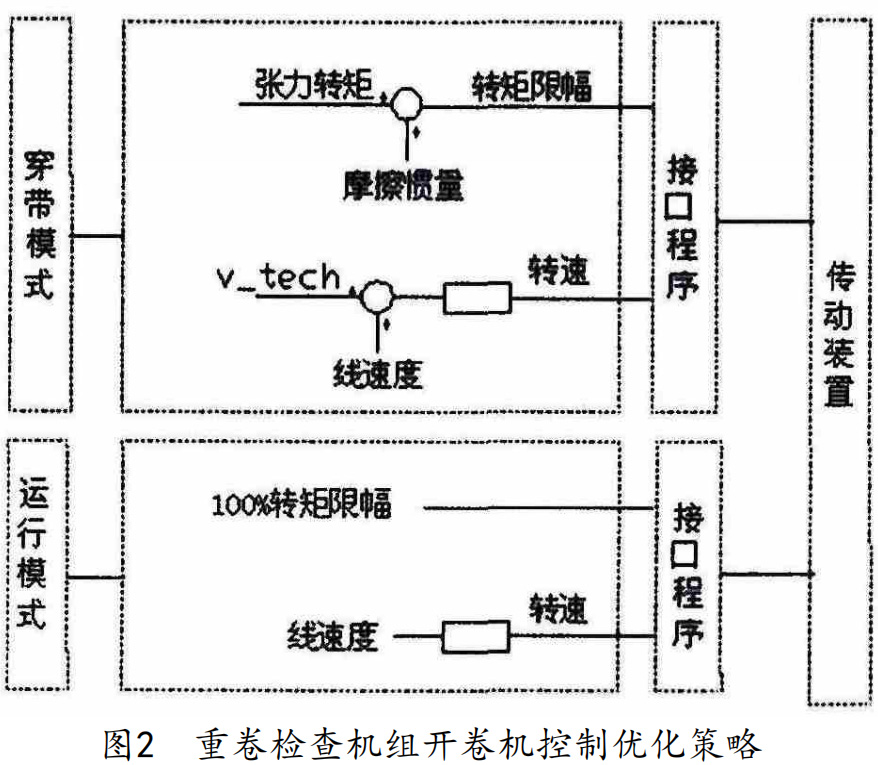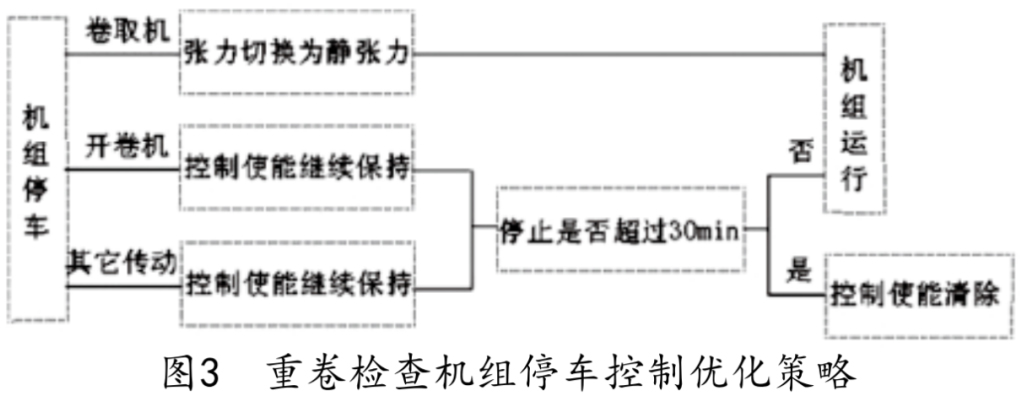PLC control optimization strategy of cold rolling recoil inspection unit
The cold-rolled re-coil inspection unit is an intermediate process of the cold-rolled production line. Its main function is to cut the large coil into smaller outer diameter coils and inspect the surface quality of the coils. It should be transported to the re-roll inspection unit for inspection and sub-rolling, and then transported to the packaging unit to be packaged and shipped.
The entrance of the rewinding inspection unit includes uncoiler, entrance turning roll, straightening machine, entrance shear, 1# pinch roll; then the unit passes through welding machine, crescent shear, disc shear, inspection room, 2# pinch roll, oiling machine, exit shear, exit pinch roller, and arrive at the coiler. The layout of the unit from the welder to the coiler is shown in Figure 1:
圖1 重卷檢查機(jī)組焊機(jī)到卷取機(jī)工藝布置圖
Since the length of the rewinding inspection unit is longer than that of the general rewinding unit, and there is no tension roller in the central part of the unit, some instability occurred in the unit in the early stage of production, but after PLC optimization control, the overall line speed and tension achieved better control results. The following describes the PLC control optimization strategy of the rewinding inspection unit from four aspects:
1. PLC control optimization strategy of uncoiler
The unit does not have a tension meter, so the tension control of the uncoiler and coiler adopts the open-loop tension control method. The open-loop tension control has no feedback of the actual value of the tension. The additional speed is added to the speed set value, so that the speed regulator is always in saturation. Drive torque is controlled by sending torque limits. In this control mode, the actual torque is always maintained at the limit value.
In the early stage of the unit's production, due to the long unit, both the uncoiler and the coiler are used for tension control. The transmission device S120 receives the torque limit issued by the PLC, and simultaneously receives the speed setting with the additional speed issued by the PLC. When the whole line of the unit is running, only the pinch rectifying roller is pressed in the central section, and its purpose is to cut off the tension between the inlet and the outlet. However, the power of the rectifying pinch roller is too small and there is no wrap angle, so the tension between the inlet and outlet cannot be separated. Under the interaction between the tension of the uncoiler and the tension of the coiler, the operation process of the unit is very unstable, and the strip steel has a large jitter.
In order to solve the jitter caused by the simultaneous tension control of the coiler and the uncoiler, the tension control of the uncoiler is handled as follows, that is, when the welding of the unit is completed, the uncoiler is switched to the speed control. as shown in picture 2.
When the unit wears the tape, the tension and speed of the uncoiler are set as follows: torque setting = tension torque + friction inertia; speed setting = (unit linear speed + process speed) × reduction ratio/roller diameter.
When the welding is completed and the whole line is running, the tension and speed of the uncoiler are set as follows: torque setting = maximum torque limit; speed setting = line speed of the unit × reduction ratio / roll diameter.

The tension and speed switching are softened in the program, that is, after the entire line is running, the tension control delay of the uncoiler is removed step by step, and the speed control setting change is also processed through the ramp.
2�����、機(jī)組停車時(shí)PLC控制優(yōu)化策略
During the operation of the rewinding inspection unit, only the coiler is used as the tension control. In the production process, due to inspection or other reasons, the unit should be suspended for a period of time, especially when the low speed is suspended, the driving rollers are in a pressed state. After the unit is suspended, the control enable of each transmission device except the coiler disappears, the brakes of each transmission roller are closed, and the tension of the central section and the tension of the inlet section of the unit cannot be maintained; when the machine is restarted, the unit will fluctuate greatly. This is mainly due to the fact that when the unit restarts, the brake cannot be opened immediately after the transmission gets the enable signal, and it takes a period of time for the tension of the unit to stabilize from the outlet to the inlet. Affect the quality of strip steel products.
In order to solve this problem, when the unit is suspended, the control of the uncoiler and other drive rollers is maintained. In this way, the holding brake of the transmission equipment can be kept open all the time, and the tension control of the coiler keeps the strip steel in a taut state all the time. When the unit restarts, once the speed reference is issued, the entire line of transmissions can respond quickly to achieve stable operation. At the same time, when the unit stops for a long time for more than a certain time, the control enable of the uncoiler and other drive rollers is cleared. The control strategy is shown in Figure 3:

3. PLC control optimization strategy for disc shear
In the early stage of the production of the unit, the shearing effect of the disc shears was not good, causing the lead and the tail to be cut off at the exit section, resulting in a large waste. The main cause of this problem is insufficient tension at the disc shears.
Due to the speed control of the uncoiler during operation, the tension of the coiler is insufficient near the disc shear after passing through the vertical inspection table. At this time, the tension at the coiler is stable and basically meets the requirements of the export process. Therefore, adjusting the tension of the coiler cannot solve the lack of tension at the disc shear. Through analysis, the tension at the disc shear can be improved if the pinch rectifying roller is made to run at a lower speed relative to the speed of the unit; therefore, the speed setting of the pinch rectifying roller is corrected in the PLC program. details as follows:
Speed ??setting = (line speed of unit - correction speed) × reduction ratio/roller diameter
Using this control method, through on-site debugging, summarizing experience, and adjusting the size of the correction speed, the tension at the disc shear can meet the actual tension required by the disc shear, and the shear effect of the disc shear is improved.
4. PLC control optimization strategy during take-up coiling
Re-coiling inspection unit The coiler is divided into upper and lower coiling. When the upper coiling is worn, the outlet swing guide is placed up, and the strip is coiled counterclockwise through the belt coiler. When the coil is down, the swing guide plate at the outlet swings down, and the strip is coiled clockwise through the belt coiler. Under the two coiling methods, the coiling effect is different. When the coil diameter is small, the coiling effect is better when the upper coil is coiled, and the strip slip occurs when the lower coil is coiled.
Because the strip is oiled by an electrostatic oiler before coiling, strip slippage is inevitable. After analysis, the main reason for the slippage of the lower coiler when the coil diameter is small is that the ladle angle of the strip is too small. In the upper coiling process, after the lead head enters the coiler, the unit establishes the tension. At this time, the exit turning roller (see Figure 1) is pressed down, so that the ladle angle of the strip becomes larger, which can improve the coiling tension fluctuation caused by the slipping of the strip. During downcoiling, the exit turning rolls cannot come into contact with the strip.
According to the process requirements, the outlet pinch rollers are opened after the unit is running. Through observation, it is found that when the coil diameter of the coiler is small, if the outlet pinch roller is not opened, the slipping phenomenon is not obvious. However, due to the small power of the motor of the outlet pinch roller, it can only be put into use when the belt is worn. If it runs at a high speed for a long time, the motor cannot bear such a large load. To solve this problem, an optimized control method is summarized, such as As shown in Figure 4:

During down coiling, the tension fluctuation caused by strip slippage is eliminated by pressing down the outlet pinch roller when the coil diameter is small, and at the same time, by controlling the upper limit speed, the motor power of the outlet pinch roller is prevented from being too large, which not only solves the problem of strip steel Tension fluctuations caused by slippage meet the design capabilities of mechanical equipment.
5 Conclusion
The electrical control of the cold-rolled re-coil inspection unit is affected by various factors, and there are often some unfavorable factors in the early stage of production. Through the adjustment of PLC control strategy, the tension and speed control effect of the unit is improved, the product quality and yield are improved, and the output requirements of the unit are met.




